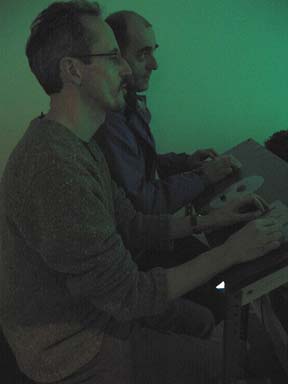
|
Lorna Mills and Sally McKay
Digital Media Tree this blog's archive OVVLvverk Lorna Mills: Artworks / Persona Volare / contact Sally McKay: GIFS / cv and contact |
View current page
...more recent posts
Tom Moody has a nice post today (with mp3s) on the recent Whitney Biennial performance by Cory Arcangel and Beige. Follow the link to Thickeye's review. These folks are doing some great music/tech/art stuff, "dirtstyle," both in performance and online.

photo by Germaine Koh of weewerk (thanks G!)
You've read about Joe McKay's Colour Game, now you can play it (if you are in Toronto). This week only at weewerk!

photo by Bunnie (me making a save, J
"Sirens intended to warn Pickering residents of a safety risk at the nearby nuclear plant are gathering dust in a warehouse after local politicians refused to install them, calling them Cold War "monstrosities" and a threat to property values." Toronto Star Mar. 3, 2004.
Pickering is a suburb with a great big nuclear power plant on the eastern side of Toronto. This has been quite the hilarious hullaballoo. How about those rusty old reactors bringing down property values? Well they're behind the nice burm, you see, no problem. My friend B. Smiley suggests a design for the sirens: elegant curved poles that bend down to the ground so that the siren itself can be aesthetically buried (muffled, if you will) in a pile of sand.
The Star article has dropped offline, but you can read it here, on the riderfans.com forum (for those of you south of the 49th, Canadian football fans can be scary too). This guy David W. cites the story as an example of civilian foolishness. His surreal quote: "And you wonder why the military is falling apart in this country - and will continue to do so? 'cause Canadians talk a good preparedness story but when push comes to shove they only think of themselves."
Now that Arnie has been in office for long enough that the horror has worn off, I recently felt capable of somewhat enjoying Terminator 3. My friends and I laughed pretty hard during the big car chase scene, when the terminatrix is in a giant utility truck, swinging Arnold around on the end of a hook. Things get boring, however, as the show goes on. The dialogue is mostly lame recycled jokes and the acting is middling to poor. They really drag out the plot and I must confess that humanoid-shaped cyborgs just ain't where its at right now. I'm no expert, but I think they are testing out nanotech on scarier stuff than melty chrome. Here's my (least) favourite part, the impactful, overserious voice-over narration at the end: "I finally realised that my destiny all along was not to stop the planet from nuclear destruction, but to survive it." Niiiice. Him and his pretty future wife with their future kids swimming around in their gonads, all locked up together nice and safe in an empty presidential bunker. Time to go check on my trip-wire mine field, barbed-wire fence, and stockpiles of bottled water, plastic sheets and duct tape.
Populist mathematician John Mighton (who wrote a book called The Myth of Ability) on Wittgenstein:
Wittgenstein initially believed that philosophy, like mathematics, could be reduced to logic. He felt that everyday language was too vague for philosophy. He inspired other philosophers to create artificial languages so you could talk about things precisely. From an old profile in Saturday Night Magazine
Laparoscopic surgeon and writer of odd-ball, award winning books, Leonard Shlain on the alphabet:
When beaded together on a horizontal line in a particular sequence these symbols became a decipherable code and made commonplace the ability to record and transfer information with relative ease.
An ideogram or hieroglyph is basically a picture that may contain multiple concepts all superimposed upon one another. The alphabet, on the other hand, strings out these concepts so that they become words in a sentence whose meaning depends on their linear sequence. Untangling the multiple ideas coiled within an ideographic image and converting them to linear code reinforces the belief that one thing follows another, and thus ever so surreptitiously alphabets impose causality upon the thinking process of those who use them. From Shlain's awkward, interesting book, Art and Physics